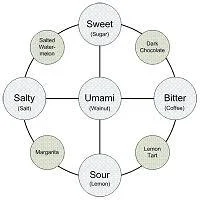Today is all about taste and what's known as "The Fifth Flavor," Umami. Huh, you say? You've heard of Sweet, Salty, Sour, Bitter, but….Umami? While many of you may not be familiar with the phrase, but accomplished chefs around the world, more and more, make Umami the focus of their cuisine. Many specialists now understand that taste is actually more complicated, with the taste buds being helped along by sense of smell, by the feel of substances in the mouth and even by the noise that food makes when we chew it. This newly found taste for a while was almost unexplainable and a bit of a mystery. But in the early 1900s, Dr. Kikunae Ikeda of the Tokyo
 |
| Dr. Kikunae Ikeda |
 |
| Photo: Mimi Oka and Doug Fitch |
 Kikkoman’s Soy Sauce has begun an advertising campaign with top chefs from around the world using Umami as part of their slogan, to raise awareness of the uses of their soy sauce products to enhance the Umami experience.
Kikkoman’s Soy Sauce has begun an advertising campaign with top chefs from around the world using Umami as part of their slogan, to raise awareness of the uses of their soy sauce products to enhance the Umami experience.For the professional chef, it is very important to create the full dining experience through the arousal of the senses. One of the largest contributors to that is taste and the foundation of taste relies on the combination of flavors and ultimate balance. There are a few rules to balancing tastes, most of which are emotional, and all of which involve complete awareness of the ingredients at hand. Ingredients are never constant, they are always changing. Today a tomato may have more water in it than it will tomorrow and the fresh basil just picked out of the garden may become a bit dull overnight. To fully balance a dish, we need to understand the tastes, temperatures and textures that go into it. Balancing hot and cold, or sweet and spicy, or acidic and salty all involve a great deal of knowledge and awareness. But all of this can be learned by the at home cook through practice and opening up your true senses.
Taste and flavor are commonly associated as one in the same, but there is a definite distinction between the two. It is said that taste is the sensation caused in the mouth by contact with a substance, while flavor is the mixed sensation of both smell and taste. To simplify this research, it would be safe to say that the formula of taste + smell = flavor. Umami as an ingredient, becomes a flavor enhancer, bringing depth to your food without covering any flavors or subtle tastes. It is found in more mature foods such as an older Parmesan cheese, aged wine, or soy sauce.
Umami rich foods are very satisfying and can actually be a healthier way to cook as well. They tend to make salt taste saltier, which means we can lower the amount of sodium in a dish when using Umami rich ingredients. It also creates a sensation that most chefs call "mouth feel," which is normally associated with the mouth sensation we get when we eat foods high in fat. Thus, we may lower the amount of fat in a dish, and let the richness of the Umami do the trick.
Here is a starter list of a few ingredients that are very Umami rich, and would lend a great deal of taste and flavor to any home cooked meal.

Seafood: fish sauce, anchovies, kombu, nori, dried bonito flakes, makeral, seabream, tuna, cod, prawns, squid, oysters, shellfish.

Meat: beef, pork and chicken.
Vegetables: dried and fresh shiitake mushrooms, corn, truffles, soy beans, potatoes, sweet potatoes, Chinese cabbage, carrots and tomatoes.
 Other Foods: Parmesan cheese and Green Tea.
Other Foods: Parmesan cheese and Green Tea.In conclusion, the ability to experience this so called, fifth taste, is totally dependent on one’s self awareness. Umami is a very powerful taste and one that I'm sure will be researched and analyzed for years to come and I encourage you to do your own experiments and research. My friends, even though we were all taught otherwise, since the time when we were children, it is time to put aside your mom's admonitions. The only way to become a better cook and be more aware is to play with your food, so get to the store, buy some Umami rich ingredients and start playing and cooking for yourselves!
Bon Appetit!
Sources: www.barmixmaster.com , www.glutamate.org , www.stratfordbar.com , www.burtfamilybutchers.co.uk





No comments:
Post a Comment